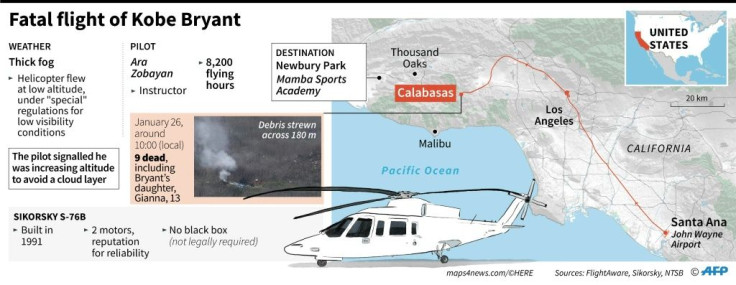Kobe Bryant Death News: Devastating Video Shows Helicopter Crash Site

KEY POINTS
- The preliminary NTSB report expected out early February won't indicate the probable cause of the fatal accident
- NTSB is looking at pilot error and bad weather as the probable causes
- “It was a pretty devastating accident scene,” said NTSB member Jennifer Homendy
The National Transportation Safety Board (NTSB) Tuesday said it plans to issue in 10 days its preliminary report on the January 26 helicopter crash in Calabasas, California that killed NBA superstar Kobe Bryant and eight others.
It also said it hopes to have a final report on the fatal crash within 12 to 18 months. This report will include findings, recommendations and the probable cause. The preliminary report won't indicate the probable cause of the crash, however.
New drone footage released by the NTSB shows exactly how devastating the crash was. A drone cam video shows a wide area of devastation. It also shows NTSB and other investigators picking through the wreckage and examining pieces of the chopper. NTSB investigators said the helicopter missed avoiding the hill by less than 30 feet.
Statements by NTSB officials, including having an aerial drone fly the exact same route the ill-fated Sikorsky S-76B executive helicopter took before it smashed at high-speed into a hillside in foggy bad weather, seems to indicate a focus on the pilot's actions leading up to the fatal accident.
The NTSB has concluded, based on evidence at hand, this was a "high-energy impact crash," meaning the helicopter was travelling quite fast when it slammed into the hillside and exploded. They also revealed the helicopter was descending in a left bank at more than 2,000 feet per minute in an apparent attempt to get below the fog to increase visibility. The helicopter also wasn't equipped with TAWS or terrain alertness and warning system similar to that on passenger planes.
As a consequence, pilot error and bad weather are being looked into as the probable causes of the fatal crash.
"We know that this was a high-energy-impact crash," said NTSB member Jennifer Homendy. "This is a pretty steep descent at high speed. So it wouldn't be a normal landing speed."
“It was a pretty devastating accident scene,” she noted.
When it smashed into the hillside at high speed, the S-76B was flying at about 184 mph (296 km/h), according to flight data. The top speed quoted for the S-76B is 178 mph, however.
The helicopter hit the ground so hard it left an impact crater located on a hillside 1,085 feet above sea level. Bits and pieces of the helicopter are scattered on both sides of the hill. The massive impact hurled debris out to an area of of 500 to 600 feet, which is bigger than a football field.

© Copyright IBTimes 2024. All rights reserved.





















